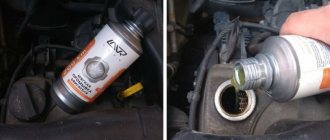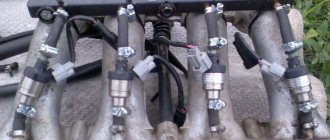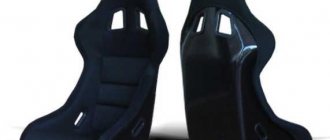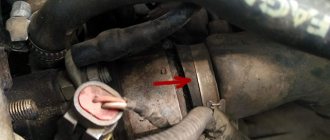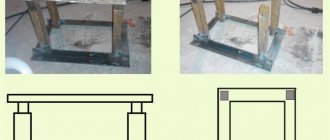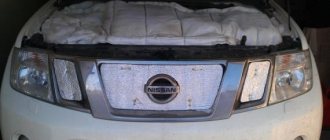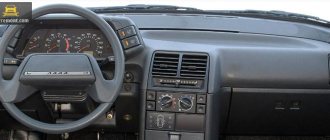Car interior plastic restorer - a review of traditional methods
Good afternoon dear friends.
It's no secret that over time, plastic parts of a car's interior lose their original appearance - they fade, become covered with scratches and stains. Every owner wants his “iron horse” to always look like new. For this, there is a special interior plastic restorer that costs a lot of money, and the effect will not always be long-lasting. There are ways to restore the plastic of a car interior from scratches and return it to its original condition without resorting to store-bought products. Today in the article we will look at several similar folk methods. They are simple and inexpensive, relative to specialized tools. Compare for yourself, and if you are lazy, they will do it for you - watch the video at the end of the material.
Restoring the plastic of a car interior - methods and solutions
Each driver of his vehicle, in one way or another, tries to take care not only of the appearance of his iron horse, but also pays a lot of attention to the interior decoration - the interior of the car. As practice shows, not only leather interiors deteriorate under the pressure of daily trips to work and at least a couple of trips to the country house and to the store. The interior of a car is where we spend a lot of time, so it’s worth paying special attention to its condition. Many owners of cars with high mileage in this case prefer to contact special services, but in this article we will tell you how to restore the plastic of the car interior with your own hands.
Tire ink
Yes, yes, you heard right. It can be used to restore plastic parts of car interiors. In order not to waste too much money, we will take homemade tire ink; its recipes are described in previous articles. The composition for blackening rubber is similar to the composition of store-bought reducing agents. It also contains glycerin, distilled water, and alcohol.
I would like to immediately warn particularly suspicious car owners. The tire blackening solution and the interior plastic restorer use the same components. Therefore, you will not harm the interior elements.
If you don’t believe me with enough experience using this method, then experiment with plastic parts of the exterior or engine compartment. If nothing happens to them, then feel free to use it in the salon.
Preparation and use
- We wash the plastic elements of the car interior. You don’t have to do this, but the effect after pre-washing will be better. All dirt and dust will be washed off from them
- We take tire ink, store-bought or homemade - it doesn’t matter. Apply it to the surface with a sponge and rub. Store-bought analogues contain products with enhanced shine or antistatic effects - if you need this, use store-bought
- Let it dry, then use a sponge again, preferably a clean one, to polish the finished surface.
Silicone
To restore the plastic of the car interior from scratches, we will use a special product from the store. Let's read its composition. It turns out that it uses regular silicone. So why overpay?
We take regular silicone grease for car door seals and apply it to the scratch. We fill it with silicone, partially masking it. Its cost is lower than purchased car interior plastic polishes - around 35 rubles. In this way, you can “disguise” small scuffs from shoes on door panels or thresholds.
Important! It is worth understanding that silicone grease will not completely remove deep scratches, but it will partially eliminate them.
Then we apply tire ink and give the parts a radical black color - cheap and looks cool.
Do-it-yourself plastic repair in the car interior
The process of restoring the plastic of a car interior consists of a certain sequence that must be strictly followed.
- Plastic areas with defects are filled with a special polymer mixture, which can be bought at a car store (for example, “around the corner”).
- It is necessary to reproduce the unique pattern of the damaged item. This is done very easily - apply the gel solution to the area nearby and after polymerization of the solution, an impression of the texture will be ready. This pattern must be re-shot onto the defective part before the special mixture completely hardens.
- Coat the repaired part with paint.
Instructional video on plastic repair:
DIY torpedo repair
A torpedo is a panel with control instruments. It is made from high-density plastic and, in case of damage, can be repainted or covered with polyvinyl chloride film, the advantage of which is excellent wear resistance.
Door plastic repair
Plastic for door trim is more popular because, compared to leather and fabric, it is easy to clean and serves its owner longer. To repair the plastic on the doors, you need a plasticizer gel, which fills the recesses and cracks in the door trim.
Painting plastic
To do this, first of all you need:
- Select the color of the paint according to the layout number.
- Mix the pigments according to the formula and add water.
- To test, apply a little to make sure the shade is correct.
Preparing for painting
It is important to sand the plastic surface well with a utility knife, removing sharp corners and burrs and ideally “smoothing” the area. Also clean the entire perimeter of any bulging, protruding pieces. Next, you need to go over it with an abrasive sponge, but be careful as you cannot touch undamaged plastic. Finally, the entire surface is thoroughly wiped with a dry cloth and areas not to be repaired are masked with masking tape.
The process of painting plastic parts
The damaged area of the plastic surface is painted in 4-5 layers of prepared paint. Be sure to maintain an interval of 10 minutes between layers at 22-25 degrees. If after five applications the result is unsatisfactory, then it is quite possible to paint it a couple more times. The result should please the eye like a “brilliant fifty dollars.”
Important! The painted plastic can be used after 24 hours.
Foam from a car wash
This product is ideal for washing dirty stains on light-colored plastic interior elements. If there is a self-service car wash in your city, then you can put the finished foam in a liter jar - this will be enough. If not, then we buy it at the nearest car wash, it costs a penny, or we make it ourselves.
Why liter? Because if you take a smaller container, then after the foam “settles”, there will be little money left in the jar. A liter is enough to renew the plastic in the car interior.
How to use
- We need to wet the surface that we will wash so that the dirt on it will acidify.
- We take the remaining foam that remains in the jar, wash the plastic with it
- Rinse with water
Restoration of car interior plastic. DIY + video
It's no secret that after a certain mileage, the plastic of the car interior (and the engine compartment) fades, becomes dull, faded, and in general, loses its original charm. Is it possible to somehow restore it, and do it all with your own hands? Or is this not real at all? It turns out you can do it in budget ways, which I’ll tell you about today. As usual there will be a text version + video at the end...
To be honest, modern plastic does not fade so quickly (the chemical industry works well). It simply gets clogged with dirt and loses its original blackness.
If the interior of your car is light or gray, then you notice black stains (or stains) that just... don’t want to go away! What to do? Clean, and on a budget. I have only three points that really work and have helped me more than once.
Car interior plastic repair and its types
Today, there are several methods that can be used to achieve good results when restoring plastic in the car interior. As mentioned above, you can contact a special service where professionals will do all the work for you. But we will take a different route and try to restore the previous appearance of the salon ourselves. First you need to decide on the recovery method:
- Spraying paint for plastic
- Reupholstering an old part with artificial or natural leather
- Pasting the part with a special film
- Grinding a plastic product with heating
All of these four methods are used today by professionals in automotive services, but this does not mean that the work of the master cannot be repeated. Let's look at each of the recovery methods in more detail.
Spraying paint for plastic
This is perhaps the simplest and most straightforward method you can use. Restoring the plastic of a car interior using this method has been practiced for quite a long time, and during this time professional craftsmen have managed to draw up a certain algorithm of work.
First you need to dismantle the damaged plastic panels using the appropriate tools. Then the parts should be thoroughly washed, cleaned of accumulated dirt and degreased with a product so as not to spoil the plastic.
In the case where there are deep scratches on the part, when restoring the element there is no way to do without putty. The corresponding places are puttied and then cleaned with fine-grain sandpaper. However, it should be noted that if the part has a corrugated surface or any pattern, then it is better to avoid the putty process. Or you need to do this very carefully!
Having completed the above manipulations, you can begin priming the part, painting it and varnishing it. The primer is applied in 2-3 layers, if necessary, after the primer, the surface is additionally sanded. All that remains is to apply paint and varnish. Both procedures must be performed in several layers. The part is ready for installation!
Restoring the plastic of a car interior - leather reupholstery
Upholstering parts with natural or artificial leather will cost you a little more, and the complexity of the work in this case increases several times. Here the main attention must be focused on accurate calculations and accuracy in carrying out restoration work. Only in this case, the restoration of the plastic interior of the car will go smoothly.
As in the previous method, it all starts with disassembling the interior, dismantling the parts necessary for restoration and cleaning them from dirt. Next, you need to cut the leather for the parts to be reupholstered. To do this, the leather product is applied to the part and a mark is made along the contour with a special marker. It is also worth noting that it is necessary to leave a couple of centimeters for allowances from the contours made.
All that remains is to cut out the skin for each part and glue it onto the plastic. For maximum quality, it is necessary to use a rubber roller, which will help to properly smooth the skin during the gluing process. Excess leather is folded under the piece, and the remainder is trimmed off. After these steps, the parts should be allowed to dry and only then carefully begin installation into place.
Vinyl film
Repairing the plastic of a car interior cannot always be done efficiently, since the part is already noticeably “tired” and restoring the appearance is an extremely difficult task. That is why vinyl film, which is used to restore the plastic interior of a car, has recently been gaining popularity. The good news is that film manufacturers offer a huge selection of films of varying quality, color and density, so there are no problems with the choice.
Restoring the plastic of a car interior using vinyl film is reminiscent of covering it with leather. After dismantling the necessary parts, they also undergo the cleaning and cutting process as described above. However, in this case, the film is removed from the substrate and glued using a hair dryer. To ensure that there are no bubbles or other irregularities left, a rubber roller or spatula is also used to level the film. All that remains is to let the part dry and you can safely install it in its rightful place!
Heat sanding
It so happened that the most affordable and fastest way to restore the plastic of a car interior ended up at the end of our list, but this does not mean that it can be neglected. If the plastic in the interior of your car is not so badly damaged, then this method will be the best solution for restoring the interior to its previous appearance.
It’s worth saying right away that in this case we don’t need to disassemble the interior, which is what makes this restoration method so simple. However, no one has canceled the process of cleaning parts! To work you will need a hair dryer. You need to work with it carefully, trying not to overheat the part. It is necessary to warm up the surface of the part and polish the plastic in a circular motion using a terry towel. The first results will be visible almost immediately - the plastic will look fresher, and minor scratches will completely disappear.
Foam from the sink
Of course, you can buy various interior cleaning products from an auto cosmetics store. However, the cost is sometimes not at all budgetary, about 300 - 400 rubles per “bottle”. BUT why overpay?
For many years now, on several cars, I have been using regular foam, the kind that is used in car washes (including self-service ones). Works great
You just need to take a jar, I take one with a large neck (and a screw-on lid), go to the car wash and ask the washer to fill the jar. Usually they always pour it for free. In the case of a self-service car wash , you must pour the foam yourself. It will cost really little, usually about 1 - 2 rubles.
After some time, the foam will settle, you will have about a third of a can of special detergent left.
Using my example, I decided to clean the plastic (restore its color) under the hood and then the door “cards” (in simple terms, the upholstery).
We start with the decorative engine cover:
- Let's get her wet first
- Then we take the foam (or rather, the product that has settled) and clean the dirt with a rag
- Wash off with water (more details in the video below)
The “lid” becomes almost black, very similar to new. Now you can tell me - “why can’t you just walk with water?” It's simple, water won't be able to completely clean the dirt, so it won't be possible to restore it to its original blackness; after drying, there will be gray stains again. Therefore, the use of shampoo is mandatory.
By the way, I decided to wash part of the plastic in the engine compartment and compare it with the part that was not washed at all.
As you can see, it turns out to be very effective, and most importantly, very budget-friendly.
Silicone
I talked about the door cards, I also washed them with foam. BUT there is one problem, at the bottom of the doors there are scuffs from shoes. They can be removed in various ways, including polishes - plastic restorers.
We take this polish and read how it restores scratches. It just applies silicone, fills the cracks, and they are partially masked.
So I have concentrated silicone, which I bought at a regular radio parts store (for 35 rubles). We take it and apply it to our “scuffs” and some of them actually hide. BUT it is not possible to remove the deep ones, this must be understood.
Tire ink
Sometimes, summer or winter, I blacken the tires of my car, they look better this way (personally, I like the option with glitter). Moreover, the composition often does not contain any ingredients that could somehow negatively affect the rubber.
Often the “ink” consists of: Glycerin, alcohols, distilled water, liquefied gas and various surfactants
BUT wait! Can it be used on plastic? YES OF COURSE YOU CAN! After all, car plastic polish (both with and without a restoration effect) often contains almost identical components.
So you can safely process it. The black velvet color is restored - “WELL”! Moreover, there are inks that have an antistatic effect (it will be written so on the bottle), which means that dust will not settle much.
After processing, the engine compartment simply sparkled black, just like on a new car. YES, the plastic door trim has also been noticeably updated.
This way you can process everything in the car, both the front panel and the central one. First we clean and wash, then silicone, then black.
Now we are watching the video version of the article.
As you can see, very useful tips, especially now in the spring, when many people are selling cars and want them to look 100%.
Moreover, the price if you break down the costs: 2 rubles foam (taking into account that you pour it yourself at a self-service car wash) + silicone 35 rubles + ink (the cheapest can be found for 60 rubles) = 97 rubles. As you can see, it's very affordable.
I’ll end here, there will be a lot more useful materials. Sincerely yours, AUTOBLOGGER
(
3 votes, average: 5.00 out of 5)
Types and causes of damage to plastic
Scratches on the plastic of a torpedo are a common occurrence. They can be caused by various objects, or even the opening and closing of doors. This is due to the fact that plastic surfaces do not have an anti-shock coating, and the slightest mechanical impact leads to a flaw. Minor defects and deep scratches on the instrument panel spoil the appearance of the car’s interior as a whole. However, such damage can be corrected without dismantling the plastic elements.
Direct sunlight causes the paint on the interior parts of the car to fade. To restore such a part, it will be necessary to carry out a major overhaul of the element.
How to remove scratches on plastic inside a car
To remove scratches from plastic in a car, use several methods:
- Small defects can be eliminated using thermal treatment. To do this, use a hairdryer or lighter.
- Small damages are removed with special restorative napkins and towels.
- Deep defects are painted over with automotive wax pencils.
- Scratches are removed from glossy surfaces with polishes and abrasive gels.
- Cracks, chips and deep damage to the paintwork of the torpedo can be eliminated by overhauling the part.
Repair of corrugated surfaces is not possible. They cannot be polished or heat treated. When such elements wear out, they are replaced with new ones.
Restorative pencils and napkins
One of the simplest methods for restoring the appearance of a damaged part is to use special napkins, microfiber towels and a pencil to remove scratches from plastic. However, the use of these means to eliminate defects has a number of nuances:
- Napkins and towels make it possible to get rid of minor scratches on the plastic surface of a car dealership.
- Deep chips and scratches can be erased with a special pencil. These devices are sold in car dealerships. The advantage of this product is its effectiveness. The substance fills defects and gives the surface its original appearance. However, keep in mind that only an original pencil can cope with the problem. Its cost is high, and cheap Chinese analogues will be of little help if the car's dashboard is scratched.
- When painting, select the pencil color that is closest to the shade of the dashboard. Otherwise, after restoration, black marks remain on the surface, spoiling the appearance of the part.
Types of repairs
Regular use leads to wear, aging and cracking of the polymer base. Any sudden movement can change the appearance of the plastic. Fragile products require the right approach to maintain their shape and restore their original appearance.
There are several methods for restoring plastic. These include:
- Spike;
- Gluing;
- Primer and painting;
- Leather wrapping.
Soldering plastic
Restoration of plastic can be carried out in different ways. The simplest is soldering. Such manipulations allow you to get rid of small cracks and large chips. To do this, you need to purchase special equipment that, under the influence of high temperature, will help connect the polymer particles to each other.
An electric soldering iron requires special care during operation. To work, you will need protective gloves, glasses, a set of pliers and a metal spatula.
Before starting the work process, it is necessary to examine the damaged area. Metal staples can be used to solder plastic. They are used to eliminate large defects.
Soldering is carried out in the following order:
- The soldering iron is carefully passed along the crack. Plastic products are held with pliers to prevent burns;
- Gently run a metal spatula over the heated surface. This tool will help make the connection boundaries smooth and almost invisible;
- When the plastic seam hardens, it is treated with sandpaper and fine abrasiveness. When performing this manipulation, special care must be taken.
Gluing broken plastic
This type of repair is considered the simplest and most popular for motorists.
For work use:
- Special glue;
- Primer composition;
- Fiberglass;
- Sandpaper;
- Paint and varnish compositions.
The damaged surface is treated with a primer, the composition of which will allow the damage to be firmly connected. For high-quality gluing it is necessary to apply 3 layers. During the selection process, it is important to consider the components included in the composition. They must be resistant to temperature changes, high humidity and regular mechanical tests.
After this, carefully distribute the adhesive composition. Next, the broken elements are connected to each other. Remains of glue are removed with a non-woven cloth. For a more durable fixation, a small fiberglass element is glued.
Sandpaper will help make the joints smoother. During the friction process, it is possible to get rid of the remaining fiberglass and dried glue. Subsequently, such a surface is re-primed and finishing is started.
The paint composition is distributed using a spray bottle. Each layer should dry within one hour. The main requirement before starting painting is the correct selection of car paint.
Removing dents on the surface of plastic parts
A dent in the plastic may occur as a result of careless use. The defect can be removed using a special varnish.
The recovery process takes place in several stages:
- We dismantle the damaged part;
- We remove any remaining dirt and degrease the surface. To do this, you will need an acid-free degreaser;
- If there is a large dent on the plastic, you can get rid of it using putty. Before you start applying putty, you need to apply a primer, which will increase the speed of adhesion of the elements to each other;
- Excess putty and varnish are removed with sandpaper. The movement is in one direction;
- Now you can move on to applying car paint. To do this, you will need a spray bottle that evenly distributes the coloring composition over the plastic base.
It is necessary to apply a protective coating until the plastic acquires a homogeneous base. If this manipulation was not possible the first time, then the excess will be removed with sandpaper.
We tighten the plastic with leather
If the plastic has deteriorated inside the leather interior, then this part needs to be re-upholstered.
To do this, you must follow a certain sequence:
- Preparation of tools and materials. Before starting work, you need to familiarize yourself with the structure of the upholstery surface. To restore the damaged area, natural leather or leatherette is selected. In the selection process, the tone and shade palette are taken into account;
- We select the adhesive composition. It should be suitable for connecting the plastic base and the leather surface;
- Electric soldering iron;
- Sharp knife.
First of all, it is necessary to restore the plastic under the skin. To do this, use an electric soldering iron, which, under the influence of high temperature, helps to connect the plastic elements.
Next, remove the damaged skin from the surface of the plastic. Leather material can be fixed using an adhesive composition. To do this, carefully distribute it with a thin brush. We apply decorative material to the base.
Remove excess with a sharp knife, taking into account allowances. To do this, it is enough to leave 1 cm each. In the future, they will be carefully fixed on the back side. You can remove creases on the leather surface using a plastic roller.
Covering plastic with film
Restoring plastic parts using film allows you to get rid of minor defects. To do this, use a vinyl-based material with an adhesive bottom. What tools will you need for the job?
For this use:
- Sharp knife;
- Plastic spatulas of different lengths;
- Special hairdryer. This device allows you to tightly fix the film on a plastic base;
- Roller with a solid base. When choosing this tool, it is recommended to give preference to a rubberized model.
We begin to dismantle the damaged part. We measure the damaged area. We cut out pieces of the desired length and shape.
Before gluing the film to the defective area, the surface is first degreased. Thanks to this manipulation, it is possible to increase the adhesion area.
We apply the film with a sticky base to the plastic. We stretch its edges in different directions. If numerous bubbles of varying volumes have formed on the surface, you can get rid of them using a hair dryer. While heating the surface, remove air with a rubber roller. The movement is carried out from the center to the edges.
Overhaul of plastic
It is not always possible to repair the plastic in the car interior using simple methods. Chips, cracks, areas of faded paint - all this requires a major overhaul of the plastic elements of the car dashboard. Restoration is performed in the following way:
- The damaged part is dismantled.
- Thoroughly cleaned of dirt, degreased and polished.
- Cracks and chips are covered with a primer.
- The surface is polished.
- Apply paint and allow the element to dry.
- Cover with several layers of varnish.
- Polish until a glossy shine appears.
DIY car interior painting
In most cars, the main interior trim material is plastic. By painting specific elements of a car dealership, you can refresh its appearance and restore its attractiveness. Complete painting in a different color will help update the interior of the car.
In any case, restoration of interior coatings is carried out in several steps:
- Dismantling of external parts, because once assembled it is impossible to carry out high-quality painting.
- Cleaning the car dealership from dust, dirt and rust.
- Preparing surfaces for application of paints: degreasing, priming, puttying and sanding.
- Painting and varnishing of necessary areas inside the car dealership and dismantled plastic elements.
- Assembling the car to its initial form.
How to properly remove scratches from gloss
Transparent plastic is used in the design of many interior elements. The disadvantage of this material is the rapid appearance of defects: small scratches and chips, after several years of operation of the car, literally cover the entire surface of the interior element. Removing scratches from car interior plastic has a number of nuances:
- Before carrying out restoration, you need to wet clean the car interior. It is necessary to ensure that there is no dust. Otherwise, new scratches may appear on the surface during polishing.
- The area to be treated will need to be thoroughly washed and degreased.
- To get rid of scratches, use a sanding machine.
- To polish the damaged area, it is recommended to use products that are designed for polishing plastic. These are special polishes and abrasive pastes. It is important to correctly calculate the amount of substance applied.
Abrasive pastes, gels and polishes, which are intended for polishing the car body, cannot be used when restoring the interior. They will ruin the part being restored.
Numerous defects, scratches, chips and cracks spoil the appearance of the car dashboard. Damage of this kind can be easily repaired on your own. To ensure that the repair process is effective and does not lead to replacement of the part, take into account the nuances of restoring the plastic elements of the interior.
Other methods of plastic restoration
Intensive use of a car wears out the “freshness” of the interior coating. Such defects can be eliminated without the help of a specialist.
Self-restoration products are similar to household chemicals. These are microfiber towels or wax crayons. They operate on the same principle as on the farm. Rags polish the surface, and pencils erase small scratches and cracks. The composition includes aluminum powder, oils and impregnations. They add shine and fill in damage.
These methods of restoring the coating will prolong the quality of the appearance if you do not intend to sell the car. Otherwise, you should seek the services of specialists. The details will be updated and the selling price will not drop.
Let us remind you that you should deal with minor damage yourself. The compositions of towels and pencils are not aggressive and will not cope with chemical or deep defects. Purchasing heavy artillery against them can be a risk to your health. Detailing centers offer professional restoration and a guarantee that the next day the paint will not peel off, the film will not peel, and the polish will not attract a layer of road dust.
